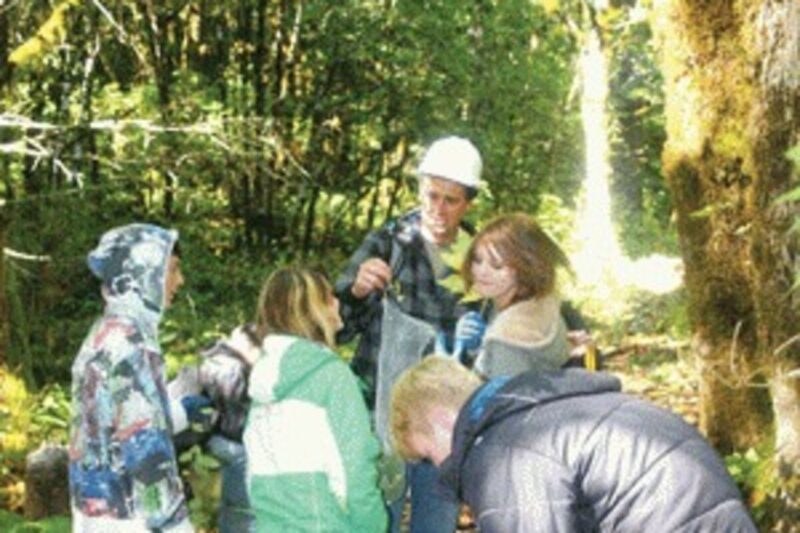Sean C. Morgan
Of The New Era
Local high school students helped Sweet Home Ranger District botanist Krista Lopez set up experiments to test the effectiveness of a wild upper Willamette steelhead habitat improvement project on Moose Creek.
The project included the placement of logs into Moose Creek to provide cover for steelhead. Lopez needs to test whether the log placement is providing the food sources necessary to the fish that will use the habitat.
Wednesday morning, fisheries biologist K.C. Briggs and Lopez explained the experiment to about 10 students who are part of the Santiam Wilderness Academy, an outdoor school operated by Community Services Consortium and School District 55. The program is aimed at students who have difficulty in a traditional classroom setting. It is open to at-risk youth as well as those interested in the outdoor classroom setting.
Lopez explained that leaf packages placed in the river at the improvement area as well as upstream and downstream will show how the project has affected the stream in terms of insects that serve as a food source.
The credit for the habitat project goes to the South Santiam Watershed Council, Briggs said. It was the council’s project with the Forest Service working in partnership to provide the technical work.
The fish are listed as “threatened,” Briggs said, and the log placement project will serve as grounds for spawning and rearing juvenile fish.
The South Santiam River is one of only two rivers in the Willamette Basin that supports the core genetic legacy population of the steelhead, she said. Moose Creek, a tributary of the South Santiam, is deficient in large woody debris. This deficiency causes the creek’s inability to retain nutrients and spawning gravel, creating poor rearing habitat.
Total cost for the project was $210,000, with $75,000 from the council, $90,000 from the Forest Service and $45,000 in federal Title II money.
During the project, logs were cut and set into the river by helicopter. Boulders were transported by truck, and some trees were pulled down with the root ball intact to keep the logs from being washed downstream during storms.
Students will help monitor the project area this winter.
The high school students “did a great job yesterday,” she said. “Their teachers are great. As a result of their interest level, I think the data will be valuable, good data.”
In three weeks, the students will evaluate the data with Lopez, she said. “I will be using the data in my long-term data set.
“Getting any kids, especially these kids, out into the woods is beneficial no matter what.”
“It was awesome,” Lopez said. “They’re great kids, super enthusiastic. They’re really curious.”
They put together mesh bags full of four types of leaves and secured them in the stream.
“I didn’t even go into the creek for site two,” Lopez said. “They were really productive.”
Through it, students are connected to the forest and to the community, Briggs said. It offers a good opportunity for success for the students.
“I feel fortunate in my role as a fisheries biologist that we have organizations like CSC that we can partner with to get kids out into the woods,” she said.
The work itself is important, she said. The steelhead are an important part of the local ecology and “when I have children, I want them to be able to see upper Willamette winter steelhead. I don’t want that population to go extinct.”
The logs provide the habitat the steelhead need for breeding, and the cover the young need to grow, she said. The more tangible benefits to the community is the opportunity to teach children about fisheries, ecosystems and watershed issues.
The project serves as a field trip site for local schools, she said. This was the third group to visit the site this month. It is low elevation, so it is accessible most of the year.
At the end of the leaf experiment, in which the students learn to use the scientific method, the students will write a scientific paper for Lopez.





